This is what a two-stroke engine looks like:
You find two-stroke engines in such devices as chain saws and jet skis because two-stroke engines have three important advantages over four-stroke engines:
These advantages make two-stroke engines lighter, simpler and less expensive to manufacture. Two-stroke engines also have the potential to pack about twice the power into the same space because there are twice as many power strokes per revolution. The combination of light weight and twice the power gives two-stroke engines a great power-to-weight ratio compared to many four-stroke engine designs.
You don't normally see two-stroke engines in cars, however. That's because two-stroke engines have a couple of significant disadvantages that will make more sense once we look at how it operates.

You can now see that two-stroke engines have two important advantages over four-stroke engines: They are simpler and lighter, and they produce about twice as much power. So why do cars and trucks use four-stroke engines? There are four main reasons:
Each time a new charge of air/fuel is loaded into the combustion chamber, part of it leaks out through the exhaust port. That's why you see a sheen of oil around any two-stroke boat motor. The leaking hydrocarbons from the fresh fuel combined with the leaking oil is a real mess for the environment.
These disadvantages mean that two-stroke engines are used only in applications where the motor is not used very often and a fantastic power-to-weight ratio is important.
In the meantime, manufacturers have been working to shrink and lighten four-stroke engines, and you can see that research coming to market in a variety of new marine and lawn-care products.

You can understand a two-stroke engine by watching each part of the cycle. Start with the point where thespark plug fires. Fuel and air in the cylinder have been compressed, and when the spark plug fires the mixture ignites. The resultingexplosion drives the pistondownward. Note that as the piston moves downward, it is compressing the air/fuel mixture in the crankcase. As the piston approaches the bottom of its stroke, the exhaust port is uncovered. The pressure in the cylinder drives most of the exhaust gases out of cylinder, as shown here:

As the piston finally bottoms out, the intake port is uncovered. The piston's movement haspressurized the mixture in the crankcase, so it rushes into the cylinder, displacing the remaining exhaust gases and filling the cylinder with a fresh charge of fuel, as shown here:
Note that in many two-stroke engines that use a cross-flow design, the piston is shaped so that the incoming fuel mixture doesn't simply flow right over the top of the piston and out the exhaust port.
Now the momentum in the crankshaft starts driving the piston back toward the spark plug for thecompression stroke. As the air/fuel mixture in the piston is compressed, a vacuum is created in the crankcase. This vacuum opens the reed valve and sucks air/fuel/oil in from the carburetor.
Once the piston makes it to the end of the compression stroke, the spark plug fires again to repeat the cycle. It's called a two-stoke engine because there is acompression stroke and then a combustion stroke. In a four-stroke engine, there are separate intake, compression, combustion and exhaust strokes.
You can see that the piston is really doing three different things in a two-stroke engine:
It's really pretty neat to see the piston doing so many different things! That's what makes two-stroke engines so simple and lightweight.
If you have ever used a two-stroke engine, you know that you have to mix special two-stroke oil in with the gasoline. Now that you understand the two-stroke cycle you can see why. In a four-stroke engine, the crankcase is completely separate from the combustion chamber, so you can fill the crankcase with heavy oil to lubricate the crankshaft bearings, the bearings on either end of the piston's connecting rod and the cylinder wall. In a two-stroke engine, on the other hand, the crankcase is serving as apressurization chamber to force air/fuel into the cylinder, so it can't hold a thick oil. Instead, you mix oil in with the gas to lubricate the crankshaft, connecting rod and cylinder walls. If you forget to mix in the oil, the engine isn't going to last very long!

A two-stroke, or two-cycle, engine is a type of internal combustion engine which completes a power cycle in only one crankshaft revolution and with two strokes, or up and down movements, of the piston in comparison to a "four-stroke engine", which uses four strokes. This is accomplished by the end of the combustion stroke and the beginning of the compression stroke happening simultaneously and performing the intake and exhaust (or scavenging) functions at the same time.
Two-stroke engines often provide high power-to-weight ratio, usually in a narrow range of rotational speeds called the "power band". Compared to 4-stroke engines, they have a greatly reduced number of moving parts, are more compact and significantly lighter.
The first commercial two-stroke engine involving in-cylinder compression is attributed to Scottish engineerDugald Clerk, who in 1881 patented his design, his engine having a separate charging cylinder. The crankcase-scavenged engine, employing the area below the piston as a charging pump, is generally credited to Englishman Joseph Day.
Gasoline (spark ignition) versions are particularly useful in lightweight (portable) applications such aschainsaws and motorcycles. They are used in diesel compression ignition engines in large and weight insensitive applications, such as ships, locomotives and electricity generation. The heat transfer from the engine to the cooling system is less in a two-stroke engine than in a four-stroke. This adds to the overall engine efficiency. Crankcase compression two-stroke engines, i.e. the common small gasoline engines, have higher exhaust emissions than four-stroke engines as their petroil lubrication mixture is also burned in the engine.
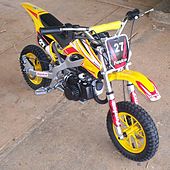

The two-stroke petrol (gasoline) engine was very popular throughout the 19th-20th century in motorcycles and small-engined devices, such as chainsaws andoutboard motors. They were also used in some cars, a few tractors and many ships. Part of their appeal was their simple design (and resulting low cost) and often high power-to-weight ratio. The lower cost to rebuild and maintain made the two stroke engine incredibly popular, until for the USA their EPA mandated more stringent emission controls in 1978 (taking effect in 1980) and in 2004 (taking effect in 2005 and 2010). The industry largely responded by switching to four-stroke petrol engines, which emit less pollution. Most small designs use petroil (two-stroke oil)) lubrication, with the oil being burned in the combustion chamber, causing "blue smoke" and other types of exhaust pollution. This is a major reason why two-stroke engines were replaced by four-stroke engines in many applications.
Simple two-stroke petrol engines continue to be commonly used in high-power, handheld applications such as string trimmers and chainsaws. The light overall weight, and light-weight spinning parts give important operational and even safety advantages. For example, a four-stroke engine to power a chainsaw operating in any position would be much more expensive and complex than a two-stroke engine that uses a gasoline-oil mixture.
These engines are still preferred for small, portable, or specialized machine applications such as outboard motors, high-performance, small-capacity motorcycles, mopeds, underbones, scooters, tuk-tuks,snowmobiles, karts, ultralights, model airplanes (and other model vehicles), lawnmowers, chain saws, weed-wackers and dirt bikes.
The two-stroke cycle is also used in many diesel engines, most notably large industrial and marine engines, as well as some trucks and heavy machinery.
A number of mainstream automobile manufacturers have used two-stroke engines in the past, including the Swedish Saab and German manufacturers DKW and Auto-Union. The Japanese manufacturer Suzuki did the same in the 1970s.[2] Production of two-stroke cars ended in the 1980s in the West, but Eastern Bloccountries continued until around 1991, with the Trabant and Wartburg in East Germany. Lotus of Norfolk, UK, has a prototype direct-injection two-stroke engine intended for alcohol fuels called the Omnivore which it is demonstrating in a version of the Exige.[5] As this uses direct fuel injection, there are dramatic decreases in emission levels and increases in fuel efficiency.

Piston port is the simplest of the designs and the most common in small two-stroke engines. All functions are controlled solely by the piston covering and uncovering the ports as it moves up and down in the cylinder. In the 1970s, Yamaha worked out some basic principles for this system. They found that, in general, widening an exhaust port increases the power by the same amount as raising the port, but the power band does not narrow as it does when the port is raised. However, there is a mechanical limit to the width of a single exhaust port, at about 62% of the bore diameter for reasonable ring life. Beyond this, the rings will bulge into the exhaust port and wear quickly. A maximum is 70% of bore width is possible in racing engines, where rings are changed every few races. Intake duration is between 120 and 160 degrees. Transfer port time is set at a minimum of 26 degrees. The strong low pressure pulse of a racing two-stroke expansion chamber can drop the pressure to -7 PSI when the piston is at bottom dead centre, and the transfer ports nearly wide open. One of the reasons for high fuel consumption in 2-strokes is that some of the incoming pressurized fuel/air mixture is forced across the top of the piston, where it has a cooling action, and straight out the exhaust pipe. An expansion chamber with a strong reverse pulse will stop this out-going flow.[6] A fundamental difference from typical four-stroke engines is that the two-stroke's crankcase is sealed and forms part of the induction process in gasoline and hot bulb engines. Diesel two-strokes often add a Roots blower or piston pump for scavenging.

The reed valve is a simple but highly effective form of check valve commonly fitted in the intake tract of the piston-controlled port. They allow asymmetric intake of the fuel charge, improving power and economy, while widening the power band. They are widely used in motorcycle, ATV and marine outboard engines.
The intake pathway is opened and closed by a rotating member. A familiar type sometimes seen on small motorcycles is a slotted disk attached to the crankshaftwhich covers and uncovers an opening in the end of the crankcase, allowing charge to enter during one portion of the cycle.
Another form of rotary inlet valve used on two-stroke engines employs two cylindrical members with suitable cutouts arranged to rotate one within the other - the inlet pipe having passage to the crankcase only when the two cutouts coincide. The crankshaft itself may form one of the members, as in most glow plug model engines. In another embodiment, the crank disc is arranged to be a close-clearance fit in the crankcase, and is provided with a cutout which lines up with an inlet passage in the crankcase wall at the appropriate time, as in the Vespa motor scooter.
The advantage of a rotary valve is it enables the two-stroke engine's intake timing to be asymmetrical, which is not possible with piston port type engines. The piston port type engine's intake timing opens and closes before and after top dead center at the same crank angle, making it symmetrical, whereas the rotary valve allows the opening to begin earlier and close earlier.
Rotary valve engines can be tailored to deliver power over a wider speed range or higher power over a narrower speed range than either piston port or reed valve engine. Where a portion of the rotary valve is a portion of the crankcase itself, it is particularly important that no wear is allowed to take place.
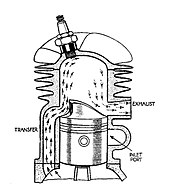
In a cross-flow engine, the transfer and exhaust ports are on opposite sides of the cylinder, and a deflector on the top of the piston directs the fresh intake charge into the upper part of the cylinder, pushing the residual exhaust gas down the other side of the deflector and out the exhaust port.[7] The deflector increases the piston's weight and exposed surface area, affecting piston cooling and also making it difficult to achieve an efficient combustion chamber shape. This design has been superseded since the 1960s by the loop scavenging method (below), especially for motorbikes, although for smaller or slower engines, such as lawn mowers, the cross-flow-scavenged design can be an acceptable approach.
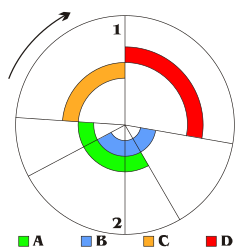
This method of scavenging uses carefully shaped and positioned transfer ports to direct the flow of fresh mixture toward the combustion chamber as it enters the cylinder. The fuel/air mixture strikes the cylinder head, then follows the curvature of the combustion chamber, and then is deflected downward.
This not only prevents the fuel/air mixture from traveling directly out the exhaust port, but also creates a swirling turbulence which improves combustion efficiency, power and economy. Usually, a piston deflector is not required, so this approach has a distinct advantage over the cross-flow scheme (above).
Often referred to as "Schnuerle" (or "Schnürle") loop scavenging after the German inventor of an early form in the mid-1920s, it became widely adopted in that country during the 1930s and spread further afield afterWorld War II.
Loop scavenging is the most common type of fuel/air mixture transfer used on modern two-stroke engines. Suzuki was one of the first manufacturers outside of Europe to adopt loop-scavenged two-stroke engines. This operational feature was used in conjunction with the expansion chamber exhaust developed by German motorcycle manufacturer, MZ and Walter Kaaden.
Loop scavenging, disc valves and expansion chambers worked in a highly coordinated way to significantly increase the power output of two-stroke engines, particularly from the Japanese manufacturers Suzuki, Yamaha and Kawasaki. Suzuki and Yamaha enjoyed success in grand Prix motorcycle racing in the 1960s due in no small way to the increased power afforded by loop scavenging.
An additional benefit of loop scavenging was the piston could be made nearly flat or slightly dome shaped, which allowed the piston to be appreciably lighter and stronger, and consequently to tolerate higher engine speeds. The "flat top" piston also has better thermal properties and is less prone to uneven heating, expansion, piston seizures, dimensional changes and compression losses.
SAAB built 750 and 850 cc 3-cylinder engines based on a DKW design that proved reasonably successful employing loop charging. The original SAAB 92 had a two-cylinder engine of comparatively low efficiency. At cruising speed, reflected wave exhaust port blocking occurred at too low a frequency. Using the asymmetric three-port exhaust manifold employed in the identical DKW engine improved fuel economy.
The 750 cc standard engine produced 36 to 42 hp, depending on the model year. The Monte Carlo Rally variant, 750 cc (with a filled crankshaft for higher base compression), generated 65 hp. An 850 cc version was available in the 1966 SAAB Sport (a standard trim model in comparison to the deluxe trim of the Monte Carlo). Base compression comprises a portion of the overall compression ratio of a two-stroke engine. Work published at SAE in 2012 points that loop scavenging is under every circumstance more efficient than cross-flow scavenging.


In a uniflow engine, the mixture, or "charge air" in the case of a diesel, enters at one end of the cylinder controlled by the piston and the exhaust exits at the other end controlled by an exhaust valve or piston. The scavenging gas-flow is therefore in one direction only, hence the name uniflow. The valved arrangement is common in on-road, off-road and stationary two-stroke engines (Detroit Diesel), certain small marine two-stroke engines (Gray Marine), certain railroad two-stroke diesel locomotives (Electro-Motive Diesel) and large marine two-stroke main propulsion engines (Wärtsilä). Ported types are represented by the opposed piston design in which there are two pistons in each cylinder, working in opposite directions such as the Junkers Jumo and Napier Deltic. The once-popular split-single design falls into this class, being effectively a folded uniflow. With advanced angle exhaust timing, uniflow engines can be supercharged with a crankshaft-driven (piston[9] or Roots) blower.
The piston of this engine is "top-hat" shaped; the upper section forms the regular cylinder, and the lower section performs a scavenging function. The units run in pairs, with the lower half of one piston charging an adjacent combustion chamber.
This system is still partially dependent on total loss lubrication (for the upper part of the piston), the other parts being sump lubricated with cleanliness and reliability benefits. The piston weight is only about 20% heavier than a loop-scavenged piston because skirt thicknesses can be less. Bernard Hooper Engineering Ltd. (BHE) is one of the more recent engine developers using this approach.
|
|
Many modern two-stroke engines employ a power valve system. The valves are normally in or around the exhaust ports. They work in one of two ways: either they alter the exhaust port by closing off the top part of the port, which alters port timing, such as Ski-doo R.A.V.E, Yamaha YPVS, Honda RC-Valve, Kawasaki K.I.P.S.,Cagiva C.T.S. or Suzuki AETC systems, or by altering the volume of the exhaust, which changes the resonant frequency of the expansion chamber, such as the Suzuki SAEC and Honda V-TACS system. The result is an engine with better low-speed power without sacrificing high-speed power. However as power valves are in the hot gas flow they need regular maintenance to perform well.
Direct injection has considerable advantages in two-stroke engines, eliminating some of the waste and pollution caused by carbureted two-strokes where a proportion of the fuel/air mixture entering the cylinder goes directly out, unburned, through the exhaust port. Two systems are in use, low-pressure air-assisted injection, and high pressure injection.
Since the fuel does not pass through the crankcase, a separate source of lubrication is needed.

Diesel engines rely solely on the heat of compression for ignition. In the case of Schnuerle ported and loop-scavenged engines, intake and exhaust happens via piston-controlled ports. A uniflow diesel engine takes in air viascavenge ports, and exhaust gases exit through an overhead poppet valve. Two-stroke diesels are all scavenged by forced induction. Some designs use a mechanically driven Roots blower, whilst marine diesel engines normally use exhaust-driven turbochargers, with electrically-driven auxiliary blowers for low-speed operation when exhaust turbochargers are unable to deliver enough air.
Marine two-stroke diesel engines directly coupled to the propeller are able to start and run in either direction as required. The fuel injection and valve timing is mechanically readjusted by using a different set of cams on the camshaft. Thus, the engine can be run in reverse to move the vessel backwards.
|
|
Most small petrol two-stroke engines cannot be lubricated by oil contained in their crankcase and sump, since the crankcase is already being used to pump fuel-air mixture into the cylinder. Traditionally, the moving parts (both rotating crankshaft and sliding piston) were lubricated by a premixed fuel-oil mixture (at a ratio between 16:1 and 100:1). As late as the 1970s, petrol stations would often have a separate pump to deliver such a premix fuel to motorcycles. Even then, in many cases, the rider would carry a bottle of their own two-stroke oil. Taking care to close the fuel-tap first, he or she would meter in a little oil (using the cap of the bottle) and then put in the petrol, this action mixing the two liquids. Two-stroke oils which became available worldwide in the 1970s are specifically designed to mix with petrol and be burnt in the combustion chamber without leaving undue unburnt oil or ash. This led to a marked reduction in spark plug fouling, which had been a factor in two-stroke engines.
More recent two-stroke engines might pump lubrication from a separate tank of two stroke oil. The supply of this oil is controlled by the throttle position. An example machine is Yamaha's PW80 (Pee-wee), a small, 80cc two stroke dirt bike designed for young children. The technology is referred to as auto-lube. This is still a total-loss system with the oil being burnt the same as in the pre-mix system, however given that the oil is not properly mixed with the fuel when burned in the combustion chamber, it translates into a slightly more efficient lubrication. This lubrication method also pays dividends in terms of user friendliness by eliminating the need to mix the gasoline constantly, makes the motor much less susceptible to atmospheric conditions (Ambient temperature, elevation) and ensures a constant, unvarying fuel-oil ratio in the combustion chamber. However, this method of lubrication is still ultimately the same as premixed gasoline in that the oil is still burnt (albeit not as completely as pre-mix) and the gas is still mixed with the oil, although not as thoroughly as in pre-mix. In addition, this method requires extra mechanical parts to pump the oil from the separate tank, to the carburetor or throttle body. In applications where performance, simplicity and/or dry weight are significant considerations, the pre-mix lubrication method is almost always used. For example a two stroke engine in a motocross bike pays major consideration to performance, simplicity and weight. Chainsaws and brush cutters must be as light as possible to reduce user fatigue and hazard, especially when used in a professional work environment.
All two-stroke engines running on a petrol/oil mix will suffer oil starvation if forced to rotate at speed with the throttle closed, e.g. motorcycles descending long hills and perhaps when decelerating gradually from high speed by changing down through the gears. Two-stroke cars (such as those that were popular in Eastern Europe in mid-20th century) were in particular danger and were usually fitted with freewheel mechanisms in the powertrain, allowing the engine to idle when the throttle was closed, requiring the use of the brakes in all slowing situations.
Large two-stroke engines, including diesels, normally use a sump lubrication system similar to four-stroke engines. The cylinder must still be pressurized, but this is not done from the crankcase, but by an ancillaryRoots-type blower or a specialized turbocharger (usually a turbo-compressor system) which has a "locked" compressor for starting (and during which it is powered by the engine's crankshaft), but which is "unlocked" for running (and during which it is powered by the engine's exhaust gases flowing through the turbine).
For the purpose of this discussion, it is convenient to think in motorcycle terms, where the exhaust pipe faces into the cooling air stream, and the crankshaft commonly spins in the same axis and direction as do the wheels i.e. "forward". Some of the considerations discussed here apply to four-stroke engines (which cannot reverse their direction of rotation without considerable modification), almost all of which spin forward, too.
Regular gasoline two-stroke engines will run backwards for short periods and under light load with little problem, and this has been used to provide a reversing facility in microcars, such as the Messerschmitt KR200, that lacked reverse gearing. Where the vehicle has electric starting, the motor will be turned off and restarted backwards by turning the key in the opposite direction. Two-stroke golf carts have used a similar kind of system. Traditional flywheel magnetos (using contact-breaker points, but no external coil) worked equally well in reverse because the cam controlling the points is symmetrical, breaking contact before top dead centre (TDC) equally well whether running forwards or backwards. Reed-valve engines will run backwards just as well as piston-controlled porting, though rotary valve engines have asymmetrical inlet timing and will not run very well.
There are serious disadvantages to running any engine backwards under load for any length of time, and some of these reasons are general, applying equally to both two-stroke and four-stroke engines. Some of this disadvantage is intrinsic, unavoidable even in the case of a complete re-design. The problem comes about because in "forwards" running the major thrust face of the piston is on the back face of the cylinder which, in a two-stroke particularly, is the coolest and best lubricated part. The forward face of the piston is less well-suited to be the major thrust face since it covers and uncovers the exhaust port in the cylinder, the hottest part of the engine, where piston lubrication is at its most marginal. The front face of the piston is also more vulnerable since the exhaust port, the largest in the engine, is in the front wall of the cylinder. Piston skirts and rings risk being extruded into this port, so it is always better to have them pressing hardest on the back wall (where there are only the transfer ports) and there is good support. In some engines, the small end is offset to reduce thrust in the intended rotational direction and the forward face of the piston has been made thinner and lighter to compensate - but when running backwards, this weaker forward face suffers increased mechanical stress it was not designed to resist.
Large two-stroke ship diesels are sometimes made to be reversible. Like four-stroke ship engines (some of which are also reversible) they use mechanically-operated valves, so require additional camshaft mechanisms.
On top of other considerations, the oil-pump of a modern two-stroke may not work in reverse, in which case the engine will suffer oil starvation within a short time. Running a motorcycle engine backwards is relatively easy to initiate, and in rare cases, can be triggered by a back-fire. It is not advisable.
Model airplane engines with reed-valves can be mounted in either tractor or pusher configuration without needing to change the propeller. These motors are compression ignition, so there are no ignition timing issues and little difference between running forward and running backward.
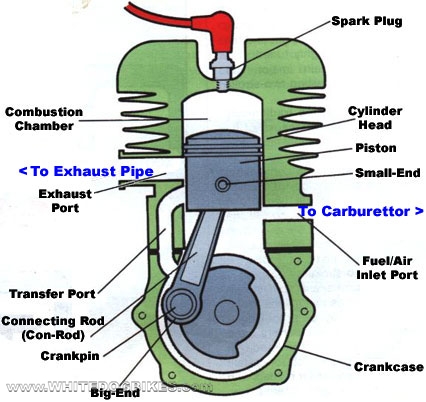
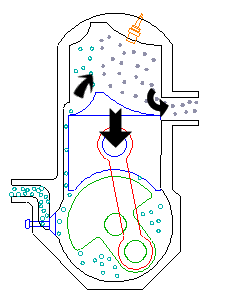
The first successful design of a three-port two-stroke Spark-ignition (S.I) engine was patented in 1889 by Joseph Day & Son of Bath. This employed the underside of the piston in conjunction with a sealed crank-case to form a scavenge pump ('scavenging' being the pushing-out of exhaust gas by the induction of fresh charge) (Fig. 1.1-5).
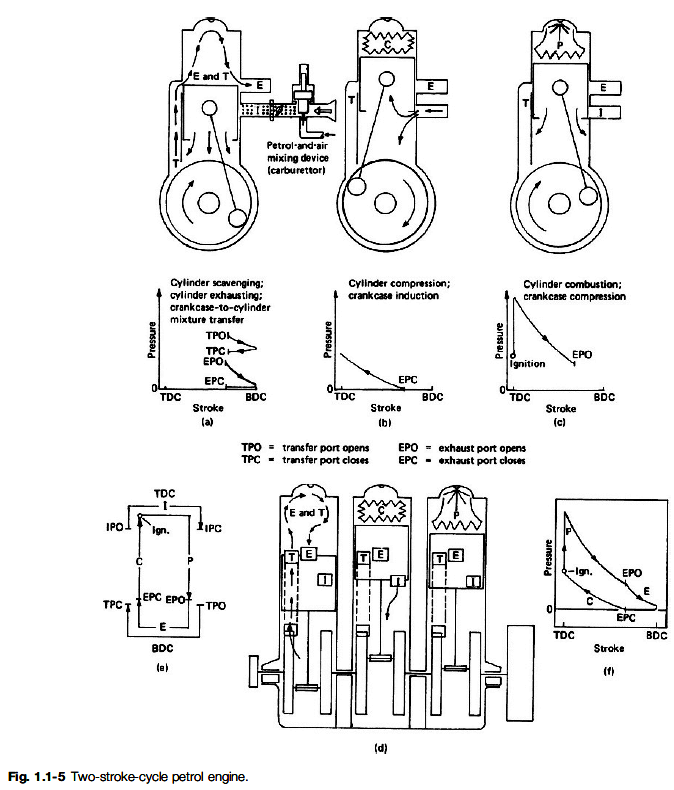
The two stroke spark-ignition (S.I) engine completes the cycle of events - induction, compression, power, and exhaust - in one revolution of the crankshaft or two complete piston strokes.
Crankcase-to-cylinder mixture transfer (Fig. 1.1-5(a)) The piston moves down the cylinder and initially uncovers the exhaust port (E), releasing the burnt exhaust gases to the atmosphere. Simultaneously the downward movement of the underside of the piston compresses the previously filled mixture of air and atomized petrol in the crankcase (Fig. 1.1-5(a)). Further outward movement of the piston will uncover the transfer port (T), and the compressed mixture in the crankcase will then be transferred to the combustion-chamber side of the cylinder. The situation in the cylinder will then be such that the fresh charge entering the cylinder will push out any remaining burnt products of combustion - this process is generally referred to as cross-flow scavenging.
Cylinder compression and crankcase induction (Fig. 1.1-5(b)) The crankshaft rotates, moving the piston in the direction of the cylinder head. Initially the piston seals off the transfer port, and then a short time later the exhaust port will be completely closed. Further inward movement of the piston will compress the mixture of air and atomized petrol to about one-seventh to one-eighth of its original volume (Fig. 1.1-5(b)).
At the same time as the fresh charge is being compressed between the combustion chamber and the piston head, the inward movement of the piston increases the total volume in the crank-case so that a depression is created in this space. About half-way up the cylinder stroke, the lower part of the piston skirt will uncover the inlet port (I), and a fresh mixture of air and petrol prepared by the carburetor will be inducted into the crank-case chamber (Fig. 1.1-5(b)).
Cylinder combustion and crankcase compression (Fig. 1.1-5(c)) Just before the piston reaches the top of its stroke, a spark-plug situated in the centre of the cylinder head will be timed to spark and ignite the dense mixture. The burning rate of the charge will rapidly raise the gas pressure to a maximum of about 50 bar under full load. The burning mixture then expands, forcing the piston back along its stroke with a corresponding reduction in cylinder pressure (Fig. 1.1-5(c)).
Considering the condition underneath the piston in the crankcase, with the piston initially at the top of its stroke, fresh mixture will have entered the crankcase through the inlet port. As the piston moves down its stroke, the piston skirt will cover the inlet port, and any further downward movement will compress the mixture in the crankcase in preparation for the next charge transfer into the cylinder and combustion-chamber space (Fig. 1.1-5(c)).
The combined cycle of events adapted to a three-cylinder engine is shown in Fig. 1.1-5(d). Figs. 1.1-5(e) and (f) show the complete cycle in terms of opening and closing events and cylinder volume and pressure changes respectively.
Valve timing diagram of a four stroke engine gives a clear idea about the actual position of the piston during the opening & closing of inlet & exhaust valves. In practice, the events of the four-stroke cycle do not start and finish exactly at the two ends of the strokes - to improve the breathing and exhausting, the inlet valve is arranged to open before TDC and to close after BDC and the exhaust valve opens before BDC and closes after TDC. These early and late opening and closing events can be shown on a valve timing diagram such as Fig. 1.1-4.

Valve lead This is where a valve opens so many degrees of crankshaft rotation before either TDC or BDC.
Valve lag This is where a valve closes so many degrees of crankshaft rotation after TDC or BDC.
Valve overlap This is the condition when both the inlet and the exhaust valves are open at the same time during so many degrees of crankshaft rotation.
Lorem ipsum dolor sit amet, consectetuer adipiscing elit. Sed rutrum feugiat sapien. Donec at mi sit amet nisi rhoncus convallis. Ut pellentesque. Proin accumsan libero ac velit. Etiam malesuada magna at ante. Vivamus congue purus sed tortor. Vestibulum malesuada nulla.
The pump scavenge two stroke diesel engine designed by Sir Dugald Clerk in 1879 was the first successful two-stroke engine; thus the two-stroke-cycle engine is sometimes called the Clerk engine. Uniflow scavenging took place - fresh charge entering the combustion chamber above the piston while the exhaust outflow occurred through ports uncovered by the piston at its outermost position.
Low- and medium-speed two-stroke marine diesels engines still use this system, but high-speed two-stroke diesel engines reverse the scavenging flow by blowing fresh charge through the bottom inlet ports, sweeping up through the cylinder and out of the exhaust ports in the cylinder head (Fig. 1.1-9(a)).
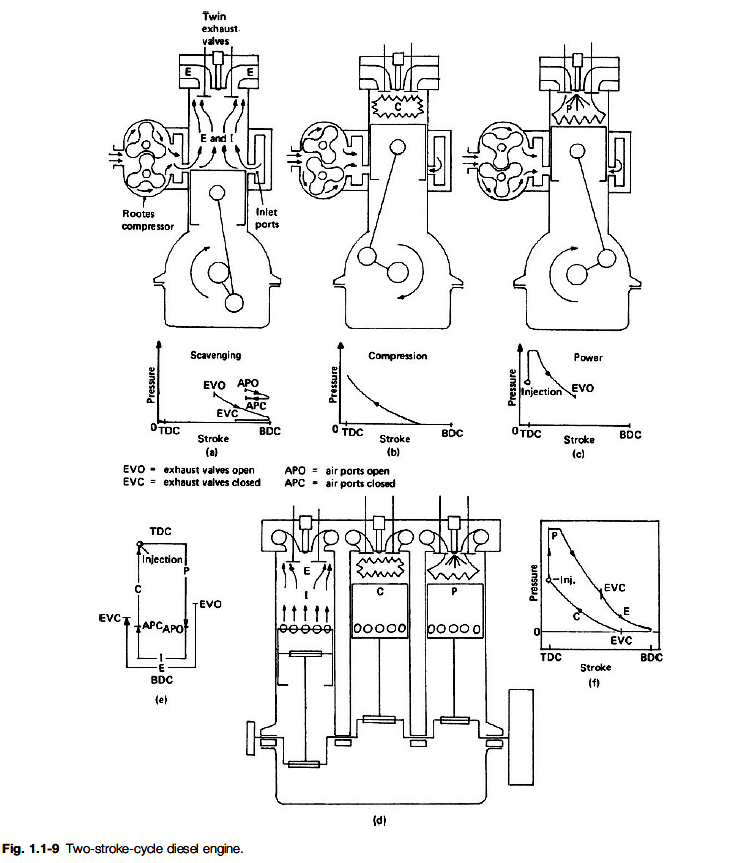
With the two-stroke diesel engine, intake and exhaust phases take place during part of the compression and power stroke respectively, so that a cycle of operation is completed in one crankshaft revolution or two piston strokes. Since there are no separate intake and exhaust strokes, a blower is necessary to pump air into the cylinder for expelling the exhaust gases and to supply the cylinder with fresh air for combustion.
Scavenging (induction and exhaust) phase (Fig. 1.1-9(a)) The piston moves away from the cylinder head and, when it is about half-way down its stroke, the exhaust valves open. This allows the burnt gases to escape into the atmosphere. Near the end of the power stroke, a horizontal row of inlet air ports is uncovered by the piston lands (Fig. 1.1-9(a)). These ports admit pressurized air from the blower into the cylinder. The space above the piston is immediately filled with air, which now blows up the cylinder towards the exhaust valves in the cylinder head. The last remaining exhaust gases will thus be forced out of the cylinder into the exhaust system. This process of fresh air coming into the cylinder and pushing out unwanted burnt gas is known as scavenging.
Compression phase (Fig. 1.1-9(b)) Towards the end of the power stroke, the inlet ports will be uncovered. The piston then reaches its outermost position and reverses its direction of motion. The piston now moves upwards so that the piston seals and closes the inlet air ports, and just a little later the exhaust valves close. Any further upward movement will now compress the trapped air (Fig. 1.1-9(b)). This air charge is now reduced to about 1/15 to 1/18 of its original volume as the piston reaches the innermost position. This change in volume corresponds to a maximum cylinder pressure of about 30-40 bar. Power phase (Fig. 1.1-9(c)) Shortly before the piston reaches the innermost position to the cylinder head on its upward compression stroke, highly pressurized liquid fuel is sprayed into the dense intensely heated air charge (Fig. 1.1-9(c)). Within a very short period of time, the injected fuel droplets will vaporize and ignite, and rapid burning will be established by the time the piston is at the top of its stroke. The heat liberated from the charge will be converted mainly into gas-pressure energy which will expand the gas and so do useful work in driving the piston outwards.
An overall view of the various phases of operation in a two-stroke-cycle three-cylinder diesel engine is shown in Figs. 1.1-9(d), and Figs. 1.1-9(e) and (f) show the cycle of events in one crankshaft revolution expressed in terms of piston displacement and cylinder pressure.
Every website you look at regarding 2 stroke and 4 stroke engines seems to make a list comparing the pros and cons of each engine. But is such a list really fair or just a comparison between a cheaply made 2 stroke and an expensive 4 stroke that has had lots of time and research put into it?
"Stroke" refers to the movement of the piston in the engine. 2 Stroke means one stroke in each direction. A 2 stoke engine will have a compression stroke followed by an explosion of the compressed fuel. On the return stroke new fuel mixture is inserted into the cylinder.
A 4 stroke engine has 1 compression stroke and 1 exhaust stoke. Each is followed by a return stroke. The compression stroke compresses the fuel air mixture prior to the gas explosion. The exhaust stroke simply pushes the burnt gases out the exhaust.
A 4 stroke engine usually has a distributor that supplies a spark to the cylinder only when its piston is near TDC (top dead center) on the fuel compression stroke, ie. one spark every two turns of the crank shaft. Some 4 stroke engines do away with the distributor and make sparks every turn of the crank. This means a spark happens in a cylinder that just has burnt gasses in it which just means the sparkplug wears out faster.
Animated picture goodness showing examples of these engines can be found at carbibles.com.
Advantages
of 2 Stroke Engines:
- Two-stroke engines do not have valves, simplifying their
construction.
- Two-stroke engines fire once every revolution (four-stroke
engines fire once every other revolution). This gives two-stroke
engines a significant power boost.
- Two-stroke engines are lighter, and cost less to
manufacture.
- Two-stroke engines have the potential for about twice the power
in the same size because there are twice as many power strokes per
revolution.
Disadvantages of 2 Stroke
Engines:
- Two-stroke engines don't live as long as four-stroke engines. The
lack of a dedicated lubrication system means that the parts of a
two-stroke engine wear-out faster. Two-stroke engines require a mix
of oil in with the gas to lubricate the crankshaft, connecting rod
and cylinder walls.
- Two-stroke oil can be expensive. Mixing ratio is about 4 ounces
per gallon of gas: burning about a gallon of oil every 1,000
miles.
- Two-stroke engines do not use fuel efficiently, yielding fewer
miles per gallon.
- Two-stroke engines produce more pollution.
From:
-- The combustion of the oil in the gas. The oil makes all
two-stroke engines smoky to some extent, and a badly worn
two-stroke engine can emit more oily smoke.
-- Each time a new mix of air/fuel is loaded into the combustion
chamber, part of it leaks out through the exhaust port.
Michael Harrison
from the DeepScience BIGENZ team has this to say:
Most of what is written on advantages and disadvantages of 2
strokes Vs 4 strokes is not actually correct.
Take for example the lubrication issue of 2 stroke engines, sure small chainsaw engines may have the oil mixed with the fuel but this is not a direct result of the engine being a 2 stroke, this is just a result of someone designing a very simple engine. look at any large Caterpillar, or Detroit 2 stroke they have conventional oil sumps, oil pumps and full pressure fed lubrication systems and they are 2 stroke!
Also, the argument about valves of 4 strokes versus the reeds and ports of 2 strokes is also incorrect. Sure some simple 2 strokes may use very primative systems to achieve the conrol of fuel/air mixture into the engine and exhaust out of the engine but again this is not a function of them being 2 stroke! I've worked on 2 stroke engines that feature poppet valves in the head (like a standard 4 stroke) - but they are definately 2 stroke - it's just that engines like this are not so much in the public eye - next time an ocean liner (ship) pulls into port check out its 2 stroke, turbo charged, direct injected diesel engine!
Finally, the arguments of simplicity, weight, power to weight, and cost of manufacturing are not a function as such of 2 stroke versus 4 stroke engines. The mistake of most of these commentaries is that they are comparing a simple chainsaw 2 stroke engine with a complex 4 stroke engine from a automobile - not a very fair comparision.
As far as the exhaust emmisions of 2 strokes - check out the Surrich/Orbital 2 stroke design that Mercury outboards are using - this is as clean burning as any 4 stroke.
The ONLY correct comparison of 2 strokes with 4 strokes is that a 2 stroke can (in theory) produce twice the power of a 4 stroke for the same sized engine and the same revs.
On the highly venerated and awesome TV show, Scrapheap Challenge, at least one episode showed an animation that compared the operation of 2 stroke and 4 stroke engines. Unfortunately it looks like the animator didn't quite understand what was going on and ended up showing the same 2 stroke animation for both except that the 2 stroke animation was played twice as fast. One response defending the animation suggested it was because "that particular 4 stroke engine does fire the spark plug once every revolution."
Michael, however, dismisses that idea saying, "As for the diagram [in the Snowmobiles episode of Scrapheap Challenge] - sure small 4 stroke engines do tend to 'waste fire' the spark plug at the end of the exhaust stroke but this would not cause an explosion as depicted in the diagrams, but again here the idea of 'waste firing' has nothing to do with the 4 stroke cycle, rather it is a result of the simple design of a lawnmower motor. The diagrams should depict the inherant differances of a 2 stroke and 4 stroke engine. Hence one should show a firing every revolution and the other a firing every 2 revolutions."
At the end of the day the winner is probably going to be the one that has had more money and technology spent on it. In these days of quick and cheap international production schedules you can't take it for granted that the 4 stroke will be better. So for your particular application, line up the options and make a decision based on what's available, not based on lists that miss the key points of difference.
Sri neelakanteswara ITI



